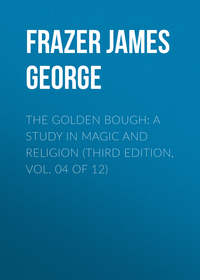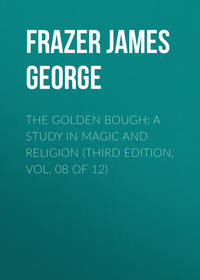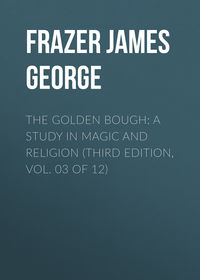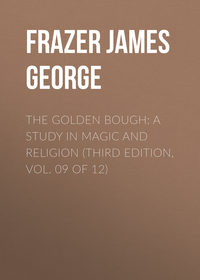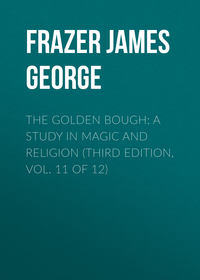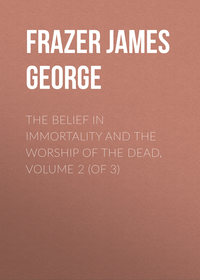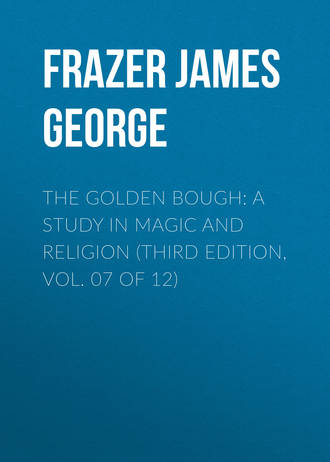 полная версия
полная версияThe Golden Bough: A Study in Magic and Religion (Third Edition, Vol. 07 of 12)
398
A. C. Kruijt, “Een en ander aangaande het geestelijk en maatschappelijk leven van den Poso-Alfoer,” Mededeelingen van wege het Nederlandsche Zendelinggenootschap, xxxix. (1895) pp. 132, 134; J. Boot, “Korte schets der noordkust van Ceram,” Tijdschrift van het Nederlandsch Aardrijkskundig Genootschap, Tweede Serie, x. (1893) p. 672; E. H. Gomes, Seventeen Years among the Sea Dyaks of Borneo (London, 1911), p. 46; E. Modigliani, Un Viaggio a Nías (Milan, 1890), pp. 590 sq.; K. Vetter, Komm herüber und hilf uns! Heft 2 (Barmen, 1898), pp. 6 sq.; Ch. Keysser, “Aus dem Leben der Kaileute,” in R. Neuhauss, Deutsch Neu-Guinea, iii. (Berlin, 1911) pp. 14, 85.
399
J. Gumilla, Histoire Naturelle, Civile et Géographique de l'Orénoque (Avignon, 1758), ii. 166 sqq., 183 sqq. Compare The Magic Art and the Evolution of Kings, i. 139 sqq.
400
S. Powers, Tribes of California (Washington, 1877), p. 23.
401
Father Geronimo Boscana, “Chinigchinich,” in [A. Robinson's] Life in California (New York, 1846), p. 287. Elsewhere the same well-informed writer observes of these Indians that “they neither cultivated the ground, nor planted any kind of grain; but lived upon the wild seeds of the field, the fruits of the forest, and upon the abundance of game” (op. cit. p. 285).
402
Father Geronimo Boscana, op. cit. pp. 302-305. As to the puplem, see id. p. 264. The writer says that criers informed the people “when to cultivate their fields” (p. 302). But taken along with his express statement that they “neither cultivated the ground, nor planted any kind of grain” (p. 285, see above, p. 125 note 2), this expression “to cultivate their fields” must be understood loosely to denote merely the gathering of the wild seeds and fruits.
403
See above, pp. 81 sq.
404
H. E. A. Meyer, “Manners and Customs of the Encounter Bay Tribe,” in Native Tribes of South Australia (Adelaide, 1879), pp. 191 sq.
405
(Sir) George Grey, Journals of Two Expeditions of Discovery in North-West and Western Australia (London, 1841), ii. 292 sq. The women also collect the nuts from the palms in the month of March (id. ii. 296).
406
(Sir) George Grey, op. cit. ii. 12. The yam referred to is a species of Diascorea, like the sweet potato.
407
R. Brough Smyth, The Aborigines of Victoria (Melbourne, 1878), i. 209.
408
P. Beveridge, “Of the Aborigines inhabiting the Great Lacustrine and Riverine Depression of the Lower Murray, Lower Murrumbidgee, Lower Lachlan, and Lower Darling,” Journal and Proceedings of the Royal Society of New South Wales for 1883, vol. xvii. (Sydney, 1884) p. 36.
409
R. Brough Smyth, The Aborigines of Victoria, i. 214.
410
W. Stanbridge, “Some Particulars of the General Characteristics, Astronomy, and Mythology of the Tribes in the Central Part of Victoria, South Australia,” Transactions of the Ethnological Society of London, N.S., i. (1861) p. 291.
411
Baldwin Spencer and F. J. Gillen, Native Tribes of Central Australia (London, 1899), p. 22.
412
O. Schrader, Reallexikon der indogermanischen Altertumskunde (Strasburg, 1901), pp. 6 sqq., 630 sqq.; id., Sprachvergleichung und Urgeschichte3 (Jena, 1905-1907), ii. 201 sqq.; H. Hirt, Die Indogermanen, i. 251 sqq., 263, 274. The use of oxen to draw the plough is very ancient in Europe. On the rocks at Bohuslän in Sweden there is carved a rude representation of a plough drawn by oxen and guided by a ploughman: it is believed to date from the Bronze Age. See H. Hirt, op. cit. i. 286.
413
Strabo, iii. 4. 17, p. 165; Heraclides Ponticus, “De rebus publicis,” 33, in Fragmenta Historicorum Graecorum, ed. C. Müller, ii. 219.
414
Tacitus, Germania, 15.
415
J. Spieth, Die Ewe-Stämme (Berlin, 1906), p. 313.
416
(Sir) G. Grey, Journals of Two Expeditions of Discovery in North-west and Western Australia (London, 1841), ii. 292.
417
W. Mannhardt, Mythologische Forschungen (Strasburg, 1884), pp. 292 sqq. See above, p. 40, note 3.
418
O. Schrader, Reallexikon der indogermanischen Altertumskunde (Strasburg, 1901), pp. 11, 289; id., Sprachvergleichung und Urgeschichte2 (Jena, 1890), pp. 409, 422; id., Sprachvergleichung und Urgeschichte3 (Jena, 1905-1907), ii. 188 sq. Compare V. Hehn, Kulturpflanzen und Hausthiere in ihrem Uebergang aus Asien7 (Berlin, 1902), pp. 58 sq.
419
Hesiod, Theog. 969 sqq.; F. Lenormant, in Daremberg et Saglio, Dictionnaire des Antiquités Grecques et Romaines, i. 2, p. 1029; Kern, in Pauly-Wissowa's Real-Encyclopädie der classischen Altertumswissenschaft, iv. 2, coll. 2720 sq.
420
My friend Professor J. H. Moulton tells me that there is great doubt as to the existence of a word δηαί, “barley” (Etymologicum Magnum, p. 264, lines 12 sq.), and that the common form of Demeter's name, Dâmâter (except in Ionic and Attic) is inconsistent with η in the supposed Cretan form. “Finally if δηαί = ζειαί, you are bound to regard her as a Cretan goddess, or as arising in some other area where the dialect changed Indogermanic y into δ and not ζ: since Ionic and Attic have ζ, the two crucial letters of the name tell different tales” (Professor J. H. Moulton, in a letter to me, dated 19 December 1903).
421
A. Kuhn, Die Herabkunft des Feuers und des Göttertranks2 (Gütersloh, 1886), pp. 68 sq.; O. Schrader, Reallexikon der indogermanischen Altertumskunde, pp. 11, 12, 289; id., Sprachvergleichung und Urgeschichte,3 ii. 189, 191, 197 sq.; H. Hirt, Die Indogermanen (Strasburg, 1905-1907), i. 276 sqq. In the oldest Vedic ritual barley and not rice is the cereal chiefly employed. See H. Oldenberg, Die Religion des Veda (Berlin, 1894), p. 353. For evidence that barley was cultivated in Europe by the lake-dwellers of the Stone Age, see A. de Candolle, Origin of Cultivated Plants (London, 1884), pp. 368, 369; R. Munro, The Lake-dwellings of Europe (London, Paris, and Melbourne, 1890), pp. 497 sq. According to Pliny (Nat. Hist. xviii. 72) barley was the oldest of all foods.
422
W. Mannhardt, Mythologische Forschungen (Strasburg, 1884), p. 296. Compare O. Hartung, “Zur Volkskunde aus Anhalt,” Zeitschrift des Vereins für Volkskunde, vii. (1897) p. 150.
423
W. Mannhardt, Mythologische Forschungen (Strasburg, 1884), p. 297.
424
Ibid. pp. 297 sq.
425
Ibid. p. 299. Compare R. Andree, Braunschweiger Volkskunde (Brunswick, 1896), p. 281.
426
W. Mannhardt, Mythologische Forschungen, p. 300.
427
W. Mannhardt, Mythologische Forschungen, p. 310.
428
Ibid. pp. 310 sq. Compare O. Hartung, l. c.
429
W. Mannhardt, op. cit. p. 316.
430
Ibid. p. 316.
431
Ibid. pp. 316 sq.
432
Ibid. p. 317. As to such rain-charms see Adonis, Attis, Osiris, Second Edition, pp. 195-197.
433
W. Mannhardt, Mythologische Forschungen, p. 317.
434
Ibid. pp. 317 sq.
435
Ibid. p. 318.
436
Ibid.
437
W. Mannhardt, op. cit. pp. 318 sq.
438
P. Sébillot, Coutumes populaires de la Haute-Bretagne (Paris, 1886), p. 306.
439
W. Mannhardt, Mythologische Forschungen, p. 319.
440
W. Mannhardt, Mythologische Forschungen, p. 320.
441
Ibid. p. 321.
442
Ibid. pp. 321, 323, 325 sq.
443
Ibid. p. 323; F. Panzer, Beitrag zur deutschen Mythologie (Munich, 1848-1855), ii. p. 219, § 403.
444
W. Mannhardt, op. cit. p. 325.
445
Ibid. p. 323.
446
Ibid.
447
A. Kuhn and W. Schwartz, Norddeutsche Sagen, Märchen und Gebräuche (Leipsic, 1848), pp. 396 sq., 399; K. Bartsch, Sagen, Märchen und Gebräuche aus Meklenburg (Vienna, 1879-1880), ii. 309, § 1494.
448
W. Mannhardt, op. cit. pp. 323 sq.
449
H. Prahn, “Glaube und Brauch in der Mark Brandenburg,” Zeitschrift des Vereins für Volkskunde, i. (1891) pp. 186 sq.
450
K. Haupt, Sagenbuch der Lausitz (Leipsic, 1862-1863), i. p. 233, No. 277 note.
451
R. Krause, Sitten, Gebräuche und Aberglauben in Westpreussen (Berlin, preface dated March 1904), p. 51.
452
P. Drechsler, Sitte, Brauch und Volksglaube in Schlesien (Leipsic, 1903-1906), ii. 65 sqq.
453
A. John, Sitte, Brauch und Volksglaube im deutschen Westböhmen (Prague, 1905), p. 189.
454
A. Kuhn, Sagen, Gebräuche und Märchen aus Westfalen (Leipsic, 1859), ii. 184, §§ 512 b, 514.
455
W. von Schulenburg, Wendisches Volksthum (Berlin, 1882), p. 147.
456
A. Jaussen, Coutumes des Arabes au pays de Moab (Paris, 1908), pp. 252 sq.
457
W. Mannhardt, Mythologische Forschungen, p. 324.
458
Ibid. p. 320.
459
W. Mannhardt, op. cit. p. 325.
460
See The Magic Art and the Evolution of Kings, ii. 74 sqq.
461
W. Mannhardt, op. cit. p. 324.
462
Ibid. pp. 324 sq.
463
Ibid. p. 325. The author of Die gestriegelte Rockenphilosophie (Chemnitz, 1759) mentions (p. 891) the German superstition that the last sheaf should be made large in order that all the sheaves next year may be of the same size; but he says nothing as to the shape or name of the sheaf. Compare A. John, Sitte, Brauch und Volksglaube im deutschen Westböhmen (Prague, 1905), p. 188.
464
W. Mannhardt, op. cit. p. 327.
465
Ibid. p. 328.
466
J. Jamieson, Dictionary of the Scottish Language, New Edition (Paisley, 1879-1882), iii. 206, s. v. “Maiden”; W. Mannhardt, Mythologische Forschungen, p. 326.
467
That is, with the reaping.
468
Rev. J. G. Campbell, Superstitions of the Highlands and Islands of Scotland (Glasgow, 1900), pp. 243 sq.
469
R. C. Maclagan, “Notes on folk-lore objects collected in Argyleshire,” Folk-lore, vi. (1895) pp. 149 sq.
470
R. C. Maclagan, op. cit. p. 151.
471
R. C. Maclagan, op. cit. p. 149.
472
Ibid. pp. 151 sq.
473
Rev. Walter Gregor, Notes on the Folk-lore of the North-East of Scotland (London, 1881), p. 182.
474
Rev. J. Macdonald, Religion and Myth (London, 1893), p. 141.
475
D. Jenkyn Evans, in an article entitled “The Harvest Customs of Pembrokeshire,” Pembroke County Guardian, 7th December 1895. In a letter to me, dated 23 February 1901, Mr. E. S. Hartland was so good as to correct the Welsh words in the text. He tells me that they mean literally, “I rose early, I pursued late on her neck,” and he adds: “The idea seems to be that the man has pursued the Hag or Corn-spirit to a later refuge, namely, his neighbour's field not yet completely reaped, and now he leaves her for the other reapers to catch. The proper form of the Welsh word for Hag is Gwrach. That is the radical from gwr, man; gwraig, woman. Wrach is the ‘middle mutation.’ ”
476
M. S. Clark, “An old South Pembrokeshire Harvest Custom,” Folk-lore, xv. (1904) pp. 194-196.
477
Communicated by my friend Professor W. Ridgeway.
478
W. Mannhardt, Mythologische Forschungen, p. 328.
479
W. Mannhardt, op. cit. p. 238.
480
Ibid. pp. 328 sq.
481
Ibid. p. 329.
482
Ibid. p. 330.
483
Ibid.
484
W. Mannhardt, op. cit. p. 331.
485
Ibid.
486
Ibid. p. 332.
487
Th. Vernaleken, Mythen und Bräuche des Volkes in Oesterreich (Vienna, 1859), p. 310.
488
Hutchinson, History of Northumberland, ii. ad finem, 17, quoted by J. Brand, Popular Antiquities of Great Britain, ii. 20, Bohn's edition.
489
E. D. Clarke, Travels in Various Countries of Europe, Asia, and Africa, Part ii., Section First, Second Edition (London, 1813), p. 229. Perhaps Morgay (which Clarke absurdly explains as μητὴρ γῆ) is a mistake for Hawkie or Hockey. The waggon in which the last corn was brought from the harvest field was called the hockey cart or hock cart. In a poem called “The Hock-cart or Harvest Home” Herrick has described the joyous return of the laden cart drawn by horses swathed in white sheets and attended by a merry crowd, some of whom kissed or stroked the sheaves, while others pranked them with oak leaves. See further J. Brand, Popular Antiquities, ii. 22 sq., Bohn's edition. The name Hockey or Hawkie is no doubt the same with the German hokelmei, hörkelmei, or harkelmei, which in Westphalia is applied to a green bush or tree set up in the field at the end of harvest and brought home in the last waggon-load; the man who carries it into the farmhouse is sometimes drenched with water. See A. Kuhn, Sagen, Gebräuche und Märchen aus Westfalen (Leipsic, 1859), ii. 178-180, §§ 494-497. The word is thought to be derived from the Low German hokk (plural hokken), “a heap of sheaves.” See Joseph Wright, English Dialect Dictionary, iii. (London, 1902) p. 190, s. v. “Hockey,” from which it appears that in England the word has been in use in Yorkshire, Cambridgeshire, and Suffolk.
490
Book ix. lines 838-842.
491
W. Mannhardt, Mythologische Forschungen, pp. 333 sq.
492
Ibid. p. 334.
493
W. Mannhardt, Mythologische Forschungen, p. 334.
494
Ibid. p. 336.
495
A. Kuhn and W. Schwartz, Norddeutsche Sagen, Märchen und Gebräuche (Leipsic, 1848), p. 397.
496
A. Peter, Volksthümliches aus Österreichisch-Schlesien (Troppau, 1865-1867), ii. 270.
497
Bavaria Landes- und Volkskunde des Königreichs Bayern, iii. (Munich, 1865) pp. 344, 969.
498
P. Drechsler, Sitte, Brauch und Volksglaube in Schlesien (Leipsic, 1903-1906), ii. 67.
499
A. John, Sitte, Brauch und Volksglaube in deutschen Westböhmen (Prague, 1905), pp. 193, 194, 197.
500
R. Wuttke, Sächsische Volkskunde (Dresden, 1901), p. 360.
501
W. Mannhardt. Mythologische Forschungen, p. 336.
502
Ibid. p. 336; W. Mannhardt, Baumkultus, p. 612.
503
A. John, Sitte, Brauch und Volksglaube im deutschen Westböhmen (Prague, 1905), p. 194.
504
E. H. Meyer, Badisches Volksleben (Strasburg, 1900), p. 437.
505
A. Kuhn, Sagen, Gebräuche und Märchen aus Westfalen (Leipsic, 1859), ii. 184 sq., § 515.
506
W. Mannhardt, Die Korndämonen (Berlin, 1868), p. 28.
507
W. Mannhardt, l. c.
508
W. Mannhardt, l. c.
509
Joseph Wright, English Dialect Dictionary, vol. i. (London, 1898) p. 605 s. v. “Churn”; id., vol. iii. (London, 1902) p. 453 s. v. “Kirn”; id. vol. iv. (London, 1903) pp. 82 sq. Sir James Murray, editor of the New English Dictionary, kindly informs me that the popular etymology which identifies kern or kirn in this sense with corn is entirely mistaken; and that “baby” or “babbie” in the same phrase means only “doll,” not “infant.” He writes, “Kirn-babbie does not mean ‘corn-baby,’ but merely kirn-doll, harvest-home doll. Bab, babbie was even in my youth the regular name for ‘doll’ in the district, as it was formerly in England; the only woman who sold dolls in Hawick early in the [nineteenth] century, and whose toy-shop all bairns knew, was known as ‘Betty o' the Babs,’ Betty of the dolls.”
510
W. Henderson, Folk-lore of the Northern Counties of England (London, 1879), pp. 88 sq.; M. C. F. Morris, Yorkshire Folk-talk, pp. 212-214. Compare F. Grose, Provincial Glossary (London, 1811), s. v. “Mell-supper”; J. Brand, Popular Antiquities, ii. 27 sqq., Bohn's edition; The Denham Tracts, edited by Dr. James Hardy (London, 1892-1895), ii. 2 sq. The sheaf out of which the Mell-doll was made was no doubt the Mell-sheaf, though this is not expressly said. Dr. Joseph Wright, editor of The English Dialect Dictionary, kindly informs me that the word mell is well known in these senses in all the northern counties of England down to Cheshire. He tells me that the proposals to connect mell with “meal” or with “maiden” (through a form like the German Mädel) are inadmissible.
511
Joseph Wright, The English Dialect Dictionary, vol. iv. (London, 1903) s. v. “Mell,” p. 83.
512
R. Chambers, The Book of Days (Edinburgh, 1886), ii. 377 sq. The expression “Corn Baby” used by the writer is probably his interpretation of the correct expression kirn or kern baby. See above, p. 151, note 3. It is not clear whether the account refers to England or Scotland. Compare F. Grose, Provincial Glossary (London 1811), s. v. “Kern-baby,” “an image dressed up with corn, carried before the reapers to their mell-supper, or harvest-home”; J. Brand, Popular Antiquities, ii. 20; W. Henderson, Folk-lore of the Northern Counties of England, p. 87.
513
Joseph Wright, The English Dialect Dictionary, iii. (London, 1902) s. v. “Kirn,” p. 453.
514
Joseph Wright, The English Dialect Dictionary, i. (London, 1898) p. 605.
515
J. Brand, Popular Antiquities, ii. 21 sq.
516
J. Jamieson, Etymological Dictionary of the Scottish Language, New Edition (Paisley, 1879-1882), iii. 42 sq., s. v. “Kirn.”
517
Mrs. A. B. Gomme, “A Berwickshire Kirn-dolly,” Folk-lore, xii. (1901) p. 215.
518
Mrs. A. B. Gomme, “Harvest Customs,” Folk-lore, xiii. (1902) p. 178.
519
J. G. Frazer, “Notes on Harvest Customs,” Folk-lore, vii. (1889) p. 48.
520
(Rev.) H. W. Lett, “Winning the Churn (Ulster),” Folk-lore, xvi. (1905) p. 185. My friend Miss Welsh, formerly Principal of Girton College, Cambridge, told me (30th May 1901) that she remembers the custom of the churn being observed in the north of Ireland; the reapers cut the last handful of standing corn (called the churn) by throwing their sickles at it, and the corn so cut was taken home and kept for some time.
521
J. Jamieson, Dictionary of the Scottish Language, New Edition (Paisley, 1879-1882), iii. 206, s. v. “Maiden.” An old Scottish name for the Maiden (autumnalis nymphula) was Rapegyrne. See Fordun, Scotichren. ii. 418, quoted by J. Jamieson, op. cit. iii. 624, s. v. “Rapegyrne.”
522
R. C. Maclagan, in Folk-lore, vi. (1895) pp. 149, 151.
523
Rev. M. MacPhail (Free Church Manse, Kilmartin, Lochgilphead), “Folk-lore from the Hebrides,” Folk-lore, xi. (1900) p. 441. That the Maiden, hung up in the house, is thought to keep out witches till the next harvest is mentioned also by the Rev. J. G. Campbell, Superstitions of the Highlands and Islands of Scotland (Glasgow, 1900), p. 20. So with the churn (above, p. 153).
524
Sir John Sinclair, Statistical Account of Scotland, xix. (Edinburgh, 1797), pp. 550 sq. Compare Miss E. J. Guthrie, Old Scottish Customs (London and Glasgow, 1885), pp. 130 sq.


